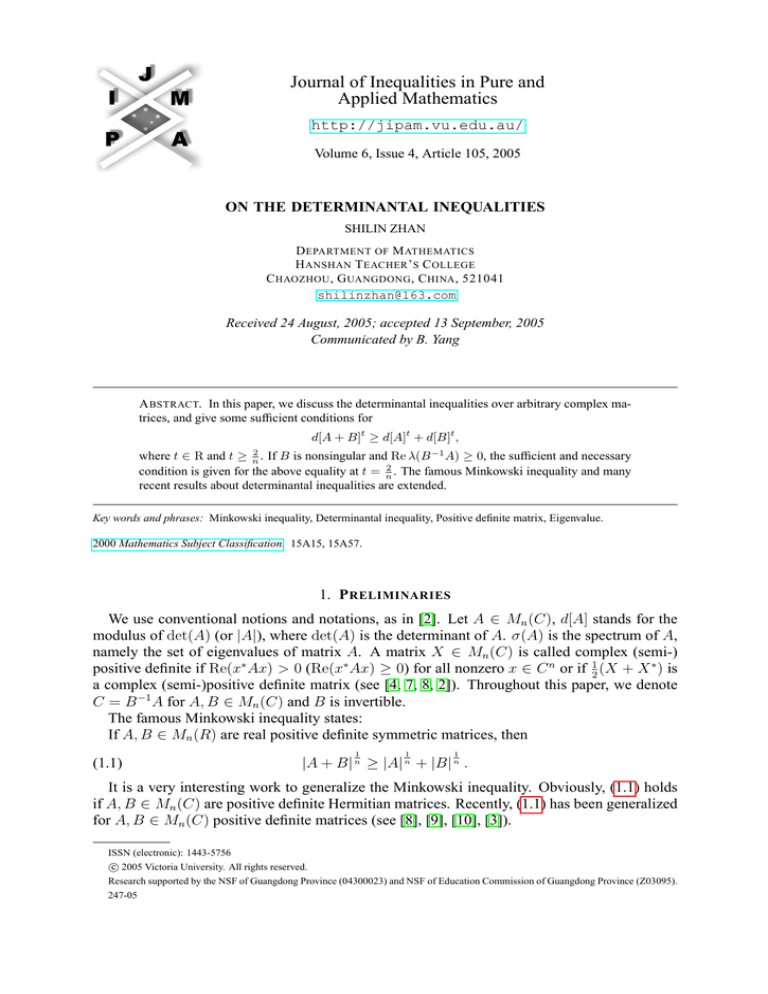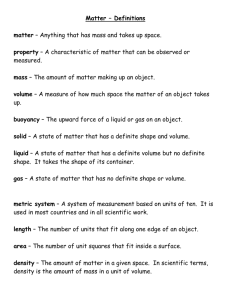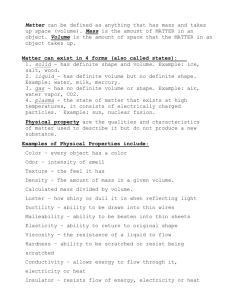
Journal of Inequalities in Pure and
Applied Mathematics
http://jipam.vu.edu.au/
Volume 6, Issue 4, Article 105, 2005
ON THE DETERMINANTAL INEQUALITIES
SHILIN ZHAN
D EPARTMENT OF M ATHEMATICS
H ANSHAN T EACHER ’ S C OLLEGE
C HAOZHOU , G UANGDONG , C HINA , 521041
shilinzhan@163.com
Received 24 August, 2005; accepted 13 September, 2005
Communicated by B. Yang
A BSTRACT. In this paper, we discuss the determinantal inequalities over arbitrary complex matrices, and give some sufficient conditions for
d[A + B]t ≥ d[A]t + d[B]t ,
where t ∈ R and t ≥ n2 . If B is nonsingular and Re λ(B −1 A) ≥ 0, the sufficient and necessary
condition is given for the above equality at t = n2 . The famous Minkowski inequality and many
recent results about determinantal inequalities are extended.
Key words and phrases: Minkowski inequality, Determinantal inequality, Positive definite matrix, Eigenvalue.
2000 Mathematics Subject Classification. 15A15, 15A57.
1. P RELIMINARIES
We use conventional notions and notations, as in [2]. Let A ∈ Mn (C), d[A] stands for the
modulus of det(A) (or |A|), where det(A) is the determinant of A. σ(A) is the spectrum of A,
namely the set of eigenvalues of matrix A. A matrix X ∈ Mn (C) is called complex (semi-)
positive definite if Re(x∗ Ax) > 0 (Re(x∗ Ax) ≥ 0) for all nonzero x ∈ C n or if 12 (X + X ∗ ) is
a complex (semi-)positive definite matrix (see [4, 7, 8, 2]). Throughout this paper, we denote
C = B −1 A for A, B ∈ Mn (C) and B is invertible.
The famous Minkowski inequality states:
If A, B ∈ Mn (R) are real positive definite symmetric matrices, then
(1.1)
1
1
1
|A + B| n ≥ |A| n + |B| n .
It is a very interesting work to generalize the Minkowski inequality. Obviously, (1.1) holds
if A, B ∈ Mn (C) are positive definite Hermitian matrices. Recently, (1.1) has been generalized
for A, B ∈ Mn (C) positive definite matrices (see [8], [9], [10], [3]).
ISSN (electronic): 1443-5756
c 2005 Victoria University. All rights reserved.
Research supported by the NSF of Guangdong Province (04300023) and NSF of Education Commission of Guangdong Province (Z03095).
247-05
2
S HILIN Z HAN
In this paper, we discuss determinantal inequalities over arbitrary complex matrices, and give
some sufficient conditions for
d[A + B]t ≥ d[A]t + d[B]t ,
(1.2)
where t ∈ R.
If B is nonsingular and Re λ(B −1 A) ≥ 0, a sufficient and necessary condition has been
given for equality as t = n2 in (1.2). The famous Minkowski inequality and many results about
determinantal inequalities are extended.
For c ∈ C, Re(c) denotes the real part of c and |c| denotes the modulus of c. Let t > 0 be
fixed, we have
Lemma 1.1. If A, B ∈ Mn (C) and B is invertible, σ(C) = {λ1 , λ2 , . . . , λn }, then inequality
(1.2) is true if and only if
n
n
Y
Y
t
(1.3)
|λi + 1| ≥
|λi |t + 1,
i=1
i=1
with equality holding in (1.2) if and only if it holds in (1.3).
Proof. Since d[A + B]t = d[B]t d[C + I]t and d[A]t + d[B]t = d[B]t (1 + d[C]t ), formula (1.2)
is equivalent to
d[C + I]t ≥ 1 + d[C]t .
(1.4)
Notice σ(C + I) = {λk + 1 : k = 1, 2, . . . , n},
n
n
Y
Y
t
t
t
d[C + I] =
|λi + 1| and d[C] =
|λi |t ,
i=1
i=1
we obtain that formula (1.4) is equivalent to (1.3). Similarly, it is easy to see that the case of
equality is true. Thus the lemma is proved.
Lemma 1.2 (see [6]). If xt , yt ≥ 0 (t = 1, 2, . . . , n), then
n
n
n
Y
Y
Y
1
1
1
n
(xt + yt ) n ≥
xt +
ytn ,
t=1
t=1
t=1
with equality if and only if there is linear dependence between (x1 , x2 , . . . , xn ) and (y1 , y2 , . . . , yn )
or xt + yt = 0 for a certain number t.
Lemma 1.3 (Jensen’s inequality). If a1 , a2 ,. . . , am are positive numbers, then
! 1s
! 1r
n
n
X
X
asi
≤
ari
for 0 < r ≤ s, n ≥ 2.
i=1
i=1
Lemma 1.4. If P1 , P2 ,. . . , Pm are positive numbers and T ≥
m
Y
(1.5)
T
(Pk + 1) ≥
k=1
m
Y
1
,
m
then
PkT + 1,
k=1
with equality if and only if Pk (k = 1, 2, . . . , n) is constant as T =
1
.
m
Proof. By Lemma 1.2, we have
m
Y
k=1
"
(Pk + 1)T =
m
Y
k=1
J. Inequal. Pure and Appl. Math., 6(4) Art. 105, 2005
#mT
(Pk + 1)
1
m
"
≥
m
Y
1
T mT
Pk
#mT
+1
.
k=1
http://jipam.vu.edu.au/
O N THE D ETERMINANTAL I NEQUALITIES
On noting that 0 <
1
mT
3
≤ 1, by Lemma 1.3, we obtain
"m
#mT
m
Y
Y
1
T mT
Pk
+1
≥
PkT + 1,
k=1
k=1
and inequality (1.5) is demonstrated. By Lemma 1.2, it is easy to see that equality holds if and
only if Pk (k = 1, 2, . . . , n) is constant as T = m1 .
Remark 1.5. Apparently, Lemma 1.3 is tenable for ai ≥ 0 (i = 1, 2, . . . , n), and Lemma 1.4 is
tenable for Pi ≥ 0 (i = 1, 2, . . . , n).
2. M AIN R ESULTS
Theorem 2.1. Let A, B ∈ Mn (C). If B is nonsingular and Re λk ≥ 0 (k = 1, 2, . . . , n), where
σ(C) = {λ1 , λ2 , . . . , λn }, then for t ≥ n2
d[A + B]t ≥ d[A]t + d[B]t ,
(2.1)
Proof. By Lemma 1.1, we need to prove inequality (1.3). Note that Re λk ≥ 0 (k = 1, 2, . . . , n)
and |λk + 1|2 ≥ 1 + |λk |2 ,
! 2t
n
n
n
Y
Y
Y
t
t
2
|λk + 1| =
|λk + 1|
≥
|λk |2 + 1 2 .
k=1
k=1
k=1
Applying Lemma 1.4, we can show that
n
Y
t
2
2
(|λk | + 1) ≥
k=1
n
Y
|λk |t + 1 for t ≥
k=1
2
,
n
with equality if and only if |λk |2 (k = 1, 2, . . . , n) is constant as t =
inequalities imply formula (1.3).
2
.
n
The above two
When t = 1, we have
Corollary 2.2. Let A, B ∈ Mn (C) (n ≥ 2). If B is invertible and Re λk ≥ 0 (k = 1, 2, . . . , n),
where σ(C) = {λ1 , λ2 , . . . , λn }, then
(2.2)
d[A + B] ≥ d[A] + d[B].
Corollary 2.3. Let A be an n-by-n complex positive definite matrix, and B be an n-by-n positive
definite Hermitian matrix (n ≥ 2). Then for t ≥ n2
(2.3)
d[A + B]t ≥ d[A]t + [det(B)]t .
1
1
1
1
Proof. Observing C = B −1 A is similar to B − 2 AB − 2 and Re λ(B − 2 AB − 2 ) > 0, where
1
1
1
1
λ(B − 2 AB − 2 ) is an arbitrary eigenvalue of B − 2 AB − 2 . Therefore, Re λk ≥ 0 and σ(C) =
{λ1 , λ2 , . . . , λn }. Hence, Theorem 2.1 yields Corollary 2.3.
When t = n2 , inequality (2.3) gives Theorem 4 of [3]. When t = 1, inequality (2.3) gives
Theorem 1 of [3]. To merit attention, Theorem 2 in [8] proves that if A is real positive definite
and Bis real positive
then (2.3) holds for t = n1 . It is untenable for example:
definite
symmetric,
1
1
1 0
A =
,B =
. Corollary 2.7 and Corollary 2.8 in this paper have been
−1 1
0 1
given correction.
J. Inequal. Pure and Appl. Math., 6(4) Art. 105, 2005
http://jipam.vu.edu.au/
4
S HILIN Z HAN
Theorem 2.4. Let A, B ∈ Mn (C). If B is nonsingular, and Re λk ≥ 0 (k = 1, 2, . . . , n), where
σ(C) = {λ1 , λ2 , . . . , λn }, then n eigenvalues of C are pure imaginary complex numbers with
the same modulus if and only if
2
2
2
d[A + B] n = d[A] n + d[B] n ,
√
Proof. If n eigenvalues of C are ±id (i = −1, d > o, d ∈ R), then
(2.4)
n
Y
|λi + 1|
i=1
2
n
=
n
Y
2
1+d
1n
2
=1+d =
n
Y
2
|λi | n + 1.
i=1
i=1
Hence equality (2.4) holds by Lemma 1.1.
Conversely, suppose (2.4) holds, then
n
Y
2
|λi + 1| n =
i=1
n
Y
2
|λi | n + 1.
i=1
So
n
Y
2
(1 + 2 Re λi + |λi | )
1
n
=
i=1
n
Y
1
(|λi |2 ) n + 1.
i=1
Obviously, Re λk = 0 (k = 1, 2, . . . , n), otherwise
n
Y
1
(1 + 2 Re λi + |λi |2 ) n >
i=1
n
Y
1 + |λi |2
i=1
1n
≥
n
Y
1
(|λi |2 ) n + 1,
i=1
with illogicality. Therefore
n
n
Y
Y
1
1
2 n
1 + (Im λi )
=
(Im λi )2 n + 1.
i=1
i=1
By Lemma 1.2 we obtain (Imλk )2 = d2 and λk = ±id (k = 1, 2, . . . , n). This completes the
proof.
Corollary 2.5. If A,B ∈ Mn (C) with B is nonsingular and C = B −1 A is skew–Hermitian,
then formula (2.4) holds if and only if A = idBU EU ∗ , where i2 = −1, d > 0, U is a unitary
matrix, E = diag(e1 , e2 , . . . , en ) with ei = ±1, i = 1, 2, . . . , n.
Proof. Since C is skew–Hermitian and its real parts of n eigenvalues are zero, then Theorem
2.4 implies that (2.4) holds if and only if
C = B −1 A = U diag(±id, ±id, . . . , ±id)U ∗ ,
where σ(C) = {±id, ±id, . . . , ±id}, d > 0 and U is unitary. Hence A = idBU EU ∗ , where
i2 = −1, d > 0, U is a unitary matrix, E = diag(e1 , e2 , . . . , en ) and ei = ±1, i = 1, 2, . . . , n.
Theorem 2.6. Suppose A, B ∈ Mn (C) with B nonsingular and Reλk ≥ 0 (k = 1, 2, . . . , n),
where σ(C) = {λ1 , λ2 , . . . , λn }. If the number of the real eigenvalues of C is r, and the non2
.
real eigenvalues of C are pair wise conjugate, then inequality (1.2) holds for t ≥ n+r
2
Proof. By Lemma 1.1, we need to prove (1.3) for t ≥ n+r
. Without loss of generality, suppose
λj ≥ 0 (j = 1, 2, . . . , r) are the real eigenvalues of C and λk , λk (k = r + 1, r + 2, . . . , r + s)
J. Inequal. Pure and Appl. Math., 6(4) Art. 105, 2005
http://jipam.vu.edu.au/
O N THE D ETERMINANTAL I NEQUALITIES
5
are s pairs of non-real eigenvalues of C, where n = r + 2s. Then the right-hand side of (1.3)
becomes
r
r+s
Y
Y
t
(2.5)
λi
|λj |2 t + 1,
i=1
j=r+1
and the left-hand side of (1.3) is
r
Y
(2.6)
(λi + 1)
i=1
r+s
Y
t
|1 + λj |2 t .
j=r+1
Given Re λk ≥ 0 (k = 1, 2, . . . , r + s), so |1 + λj |2 ≥ 1 + |λj |2 , then
r
Y
(2.7)
t
(1 + λi )
i=1
r+s
Y
2 t
|1 + λj |
j=r+1
≥
r
Y
r+s
Y
t
(1 + λi )
i=1
1 + |λj |2 t .
j=r+1
By Lemma 1.2 and (2.7), we obtain that
r
Y
i=1
(λi + 1)
t
r+s
Y
2 t
|1 + λj |
j=r+1
≥
r
Y
i=1
λti
r+s
Y
|λj |2
t
+ 1, for t ≥
j=r+1
1
2
=
.
r+s
n+r
This completes the proof.
In the following, we present some generalizations of the Minkowski inequality. By Theorem
2.6, it is easy to show:
Corollary 2.7. Let A, B ∈ Mn (C). If B is nonsingular and n eigenvalues of C are positive
numbers, then for t ≥ n1
(2.8)
1
1
1
d[A + B] n ≥ d[A] n + d[B] n .
If A is an n-by-n complex positive definite matrix and B is an n-by-n positive definite Her1
1
mitian matrix, with n eigenvalues of C being real numbers, then σ(C) = σ(B 2 CB − 2 ), and
1
1
1
1
B 2 CB − 2 = B − 2 AB − 2 is positive definite, so any eigenvalue of C has a positive real part.
Thus n eigenvalues of C are positive numbers. By Corollary 2.7 we have
Corollary 2.8. Suppose A, B ∈ Mn (C), where A is a complex positive definite matrix and B
is a positive definite Hermitian matrix. If n eigenvalues of C are real numbers, then inequality
(2.8) holds for t ≥ n1 .
Corollary 2.9 (Minkowski inequality). Suppose A, B ∈ Mn (C) are positive definite Hermitian
matrices, then inequality (1.1) holds.
Proof. Note that C = B −1 A is similar to a real diagonal matrix, and its eigenvalues are real
numbers, using Corollary 2.8 and letting t = 1, the proof is completed.
Corollary 2.10. Suppose A, B ∈ Mn (C), where A is a complex positive definite matrix and B
is a positive definite Hermitian matrix. If the non-real eigenvalues of C are m pairs conjugate
1
.
complex numbers, then inequality (1.2) holds for t ≥ n−m
Proof. Obviously Re λk ≥ 0 (k = 1, 2, . . . , n), where σ(C) = {λ1 , λ2 , . . . , λn }. Applying
Theorem 2.6 completes the proof.
Let A = H + K ∈ Mn (C), where H = 12 (A + A∗ ), and K = 12 (A − A∗ ), then we have
J. Inequal. Pure and Appl. Math., 6(4) Art. 105, 2005
http://jipam.vu.edu.au/
6
S HILIN Z HAN
Theorem 2.11. Let A = H + K be an n-by-n complex positive definite matrix, then for t ≥
2
n
d[A]t ≥ d[H]t + d[K]t ,
(2.9)
with equality if and only if K = idHQ∗ EQ as t = n2 , where i2 = −1, d > 0, Q is a unitary
matrix,E = diag(e1 , e2 , . . . , en ) with ei = ±1, i = 1, 2, . . . , n.
1
1
Proof. Since H − 2 KH − 2 is a skew-Hermitian matrix and is similar to H −1 K, Re λ(H −1 K) =
1
1
Re λ(H − 2 KH − 2 ) = 0. By Theorem 2.1 and Corollary 2.5, we get the desired result.
Let t = 1, we have the following interesting result.
Corollary 2.12. If A = H + K is an n-by-n complex positive definite matrix (n ≥ 2), then
d[A] ≥ d[H] + d[K].
(2.10)
Corollary 2.13 (Ostrowski-Taussky Inequality). If A = H + K is an n-by-n positive definite
matrix (n ≥ 2), then det H ≤ d[A] with equality if and only if A is Hermitian.
Theorem 2.14. Let A, B be two n-by-n complex positive definite matrices, and n eigenvalues
of B be real numbers. Suppose A, B are simultaneously upper triangularizable, namely, there
exists a nonsingular matrix P , such that P −1 AP and P −1 BP are upper triangular matrices,
then inequality (1.2) holds for any t ≥ n2 .
Proof. If P −1 AP and P −1 BP are upper triangular matrices, then
P −1 B −1 AP = (P −1 BP )−1 (P −1 AP )
is an upper triangular matrix, with the product of the eigenvalues of B −1 and A on its diagonal.
We denote the eigenvalue of X by λ(X). Notice that positive definiteness of A and B −1 ,
Reλ(A) and λ(B −1 ) are positive numbers by hypothesis, it is easy to see that Re λ(B −1 A) ≥ 0.
By Theorem 2.1, we get the desired result.
Corollary 2.15. Let A, B be two n-by-n complex positive definite matrices, and all the eigenvalues of B be real numbers. If r([A, B]) ≤ 1, then inequality (1.2) holds for t ≥ n2 , where
[A, B] = AB − BA, r([A, B]) is the rank of [A, B].
Proof. It is easy to see that B −1 is a complex positive definite matrix and n eigenvalues of B −1
are real numbers. By the hypothesis and r[B −1 , A] = r[A, B], we have r([B −1 , A]) ≤ 1. By
the Laffey-Choi Theorem (see [5], [1]), there exists a non-singular matrix P , such that P −1 AP
and P −1 BP are upper triangular matrices. The result holds by Theorem 2.14.
Corollary 2.16. Let A, B be two n-by-n complex positive definite matrices (n ≥ 2). Suppose
AB = BA and n eigenvalues of B are real numbers, then inequality (1.2) holds for t ≥ n2 .
Proof. Follows from Corollary 2.15 and the fact that r([A, B]) = 0.
R EFERENCES
[1] M.P. CHOI, C. LOURIE AND H. RADJAVI, On commutators and invariant subspaces, Lin. and
Multilin. Alg., 9(4) (1981), 329–340.
[2] R.A. HORN AND C.R. JOHNSON, Matrix Analysis, Cambridge University Press, 1985.
[3] NENG JIN, Inequalities on the determinant of complex positive definite matrix , Mathematics in
Practice and Theory, 30(4) (2000), 501–507.
[4] C.R. JOHNSON, Positive definite matrices, Amer. Math. Monthly, 77 (1970), 259–264.
[5] T.J. LAFFEY, Simultaneous triangularization of matrices-low rank cases and the nondcrogetory
case, Lin. and Multilin. Alg., 6(4) (1978), 269–305.
J. Inequal. Pure and Appl. Math., 6(4) Art. 105, 2005
http://jipam.vu.edu.au/
O N THE D ETERMINANTAL I NEQUALITIES
7
[6] M. MARCUS AND H. MINC, A Survery of Matrix Theorem and Matrix Inequalities, Allyn and
Bacon, Inc., Boston, 1964.
[7] BO-XUN TU, The theorem of metapositive definite matrix, Acta. Math. Sinica, 33(4) (1990), 462–
471.
[8] BO-XUN TU, The theorem of metapositive definite matrix, Acta. Math. Sinica, 34(1) (1991), 91–
102.
[9] CHAO-WEI YUAN AND ZHAO-YONG YOU, How many kinds of Minkowski inequality are generalized, Journal of Engineering Mathematics, 13(1) (1996), 15–21.
[10] HUI-PENG YUAN, Minkowski inequality of complex positive definite matrix, Journal of Mathematical Research and Exposition, 21(3) (2001), 464–468.
J. Inequal. Pure and Appl. Math., 6(4) Art. 105, 2005
http://jipam.vu.edu.au/






